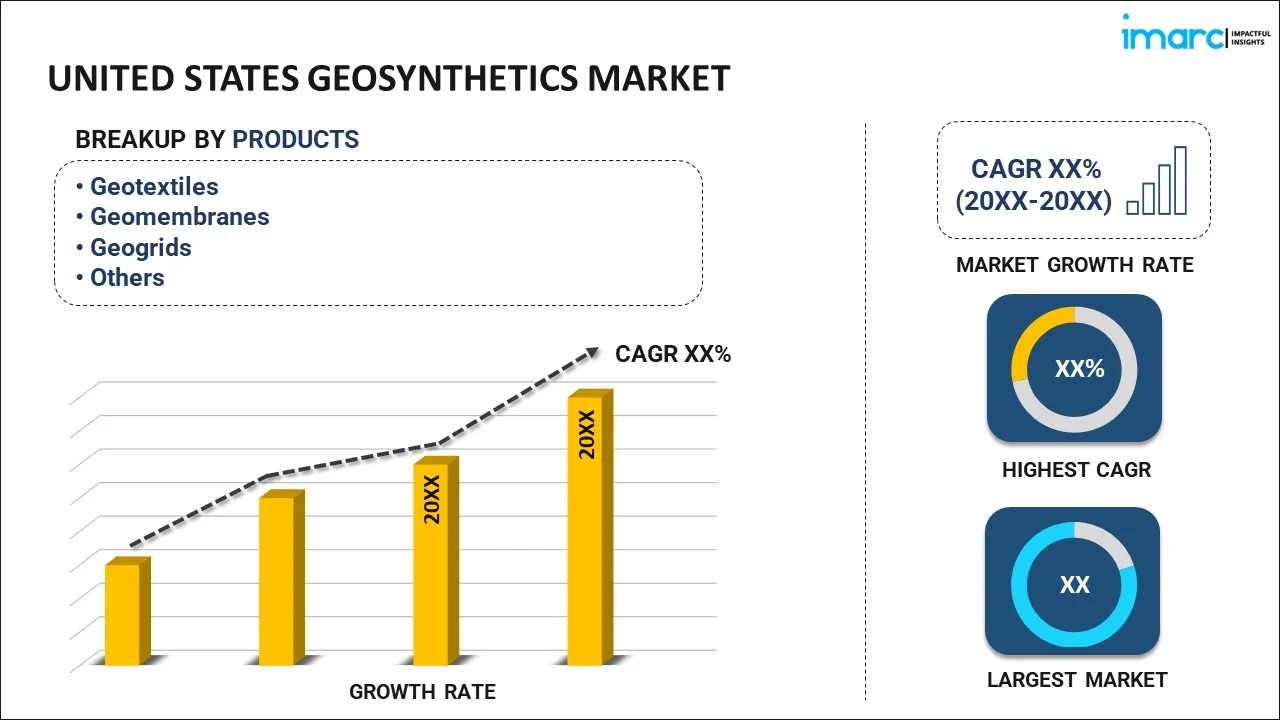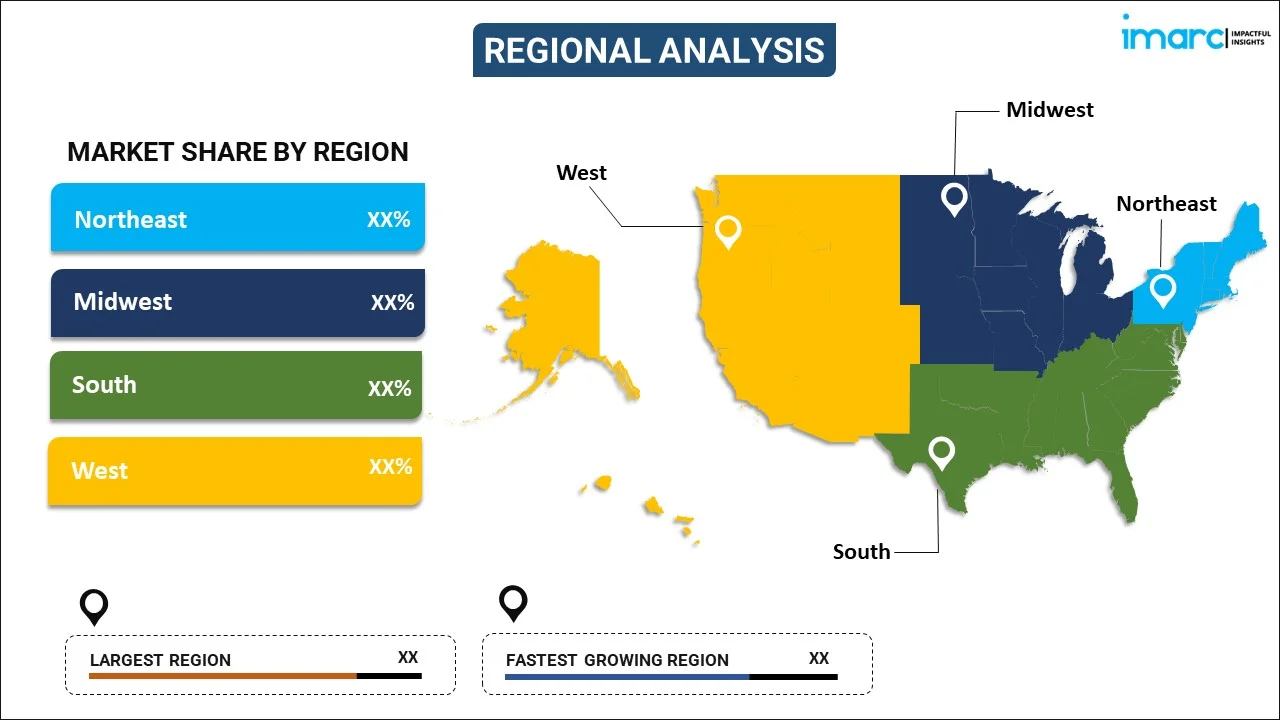
United States Geosynthetics Market Report by Product (Geotextiles, Geomembranes, Geogrids, Geonets, Geosynthetic Clay Liner (GCL), Pre-Fabricated Vertical Drains (PVD), and Others), Type (Woven, Non-Woven, Knitted, and Others), Material (Polypropylene, Polyester, Polyethylene, Polyvinyl Chloride, Synthetic Rubber, and Others), Application (Road Construction and Pavement Repair, Railroads, Drainage Systems, Soil Reinforcement and Erosion, Water and Waste Management, and Others), and Region 2025-2033
Market Overview:
United States geosynthetics market size is projected to exhibit a growth rate (CAGR) of 5.68% during 2025-2033. The rising infrastructure development activities are propelling the demand for these materials, as they can effectively address soil stabilization and erosion control, which is primarily driving the United States geosynthetics market share.
|
Report Attribute
|
Key Statistics
|
|---|---|
|
Base Year
|
2024 |
|
Forecast Years
|
2025-2033
|
|
Historical Years
|
2019-2024
|
| Market Growth Rate (2025-2033) | 5.68% |
United States Geosynthetics Market Analysis:
- Major Drivers: Increased infrastructure development operations and government spending on road construction activities are stimulating the United States geosynthetics market growth. The growing demand for soil stabilization and erosion control applications sustains market growth in different segments of construction.
- Key Market Trends: The U.S. market for geosynthetics is increasing progressively with growth through infrastructure development, environmental concerns, and sustainable construction materials demand. Geotextiles are leading by virtue of flexibility and economy, and geocells are increasingly becoming popular for soil stabilization and drainage. Smart sensor integration and other innovations are improving performance and broadening opportunities for applications across industries.
- Market Challenges: Limited awareness regarding advanced geosynthetic applications and high initial investment requirements are challenges. Fluctuating raw material prices and competition with conventional construction materials impact the United States geosynthetics market analysis outlook.
- Market Opportunities: The US geosynthetics market offers opportunities in infrastructure, environmental protection, and sustainable construction. Increased demand in water management, transportation, and waste containment is aided by government support and regulations. Advances in materials and technology, such as improved geotextiles and geocells, are broadening applications and improving efficiency across sectors.
Geosynthetics are a class of polymeric materials primarily composed of polyester, polyethylene (PE), and polypropylene (PP). This category includes geotextiles, geogrids, geonets, and geomembranes. Geosynthetics play a crucial role in a broad spectrum of applications, such as erosion control, filtration, landfills, drainage, and diverse civil engineering projects. Their cost-effectiveness, durability, and adaptability make them highly valued in various industrial sectors, including mining, transportation, and agriculture. Beyond their economic and robust qualities, geosynthetics are recognized for their ability to enhance the mechanical and physical characteristics of soil, enabling it to withstand harsh weather conditions. Consequently, geosynthetics are extensively utilized, contributing significantly to the success of numerous industrial operations and infrastructure projects.
United States Geosynthetics Market Trends:
Sustainable Construction Practices Integration
The use of geosynthetics in green building practices is a growing trend in the U.S. market. Construction firms are turning more towards these products in order to comply with environmental standards and qualify for LEED certification requirements. Geosynthetics provide greater performance in erosion control and soil stabilization while minimizing environmental footprints than conventional materials. This trend is fueled by increasing environmental sustainability awareness, government policies encouraging green building strategies, and the long-term cost savings of long-lasting geosynthetic solutions. Biodegradable and recycled geosynthetic material use is becoming more prevalent, enabling circular economy practices in construction activities. This trend is likely to gain pace as ecological awareness increases and regulatory environments become more demanding, leading to geosynthetics playing a central role in sustainable infrastructure construction in a range of applications such as road construction, landfill design, and water management systems.
Advanced Material Technology Development
Advances in geosynthetic material composition and manufacturing technologies are supporting United States geosynthetics market demand. Advances in polymer chemistry have resulted in the introduction of high-performance geosynthetics with improved durability, strength, and chemical degradation resistance. Intelligent geosynthetics with sensors and monitoring features are gaining traction, allowing real-time performance monitoring for use in critical infrastructure applications. Producers are making research and development investments in order to produce specialized products for harsh weather conditions and adverse geological environments. The marriage of nanotechnology and advanced fiber reinforcement technology is creating the next-generation geosynthetics with improved mechanical characteristics. These advances in technology are opening up application opportunities in applications ranging from mining, transportation infrastructure, to renewable energy developments. The drift towards specialized solutions designed to meet particular requirements of projects is propelling market differentiation and opening up opportunities for high-end product segments with superior performance attributes.
Infrastructure Modernization and Resilience Focus
The focus on modernizing infrastructure and climate resilience is generating enormous opportunities for geosynthetic use in the United States. Government efforts to replace aged infrastructure are boosting demand for long-lasting, low-cost solutions that geosynthetics offer. More frequent occurrences of severe weather conditions are emphasizing resilient infrastructure design, with geosynthetics playing critical roles in flood control, slope stability, and erosion control systems. Transportation authorities are adding geosynthetics to pavement rehabilitation and design projects to lengthen service life and lower maintenance expenses. The increasing emphasis on disaster preparedness and infrastructure resilience to climate change is increasing coastal protection, stormwater management, and emergency response system applications of geosynthetics. It is fueled by federal and state-sponsored funding initiatives aimed at infrastructure development and resilience, which is promoting a healthy environment for long-term market growth in a variety of application segments such as transportation, water management, and environmental protection schemes.
United States Geosynthetics Market Segmentation:
IMARC Group provides an analysis of the key trends in each segment of the market, along with forecasts at the country level for 2025-2033. Our report has categorized the market based on product, type, material, and application.
Product Insights:

To get more information on this market, Request Sample
- Geotextiles
- Geomembranes
- Geogrids
- Geonets
- Geosynthetic Clay Liner (GCL)
- Pre-Fabricated Vertical Drains (PVD)
- Others
The report has provided a detailed breakup and analysis of the market based on the product. This includes geotextiles, geomembranes, geogrids, geonets, geosynthetic clay liner (GCL), pre-fabricated vertical drains (PVD), and others.
Type Insights:
- Woven
- Non-Woven
- Knitted
- Others
A detailed breakup and analysis of the market based on type have also been provided in the report. This includes woven, non-woven, knitted, and others.
Material Insights:
- Polypropylene
- Polyester
- Polyethylene
- Polyvinyl Chloride
- Synthetic Rubber
- Others
The report has provided a detailed breakup and analysis of the market based on the material. This includes polypropylene, polyester, polyethylene, polyvinyl chloride, synthetic rubber, and others.
Application Insights:
- Road Construction and Pavement Repair
- Railroads
- Drainage Systems
- Soil Reinforcement and Erosion
- Water and Waste Management
- Others
A detailed breakup and analysis of the market based on application have also been provided in the report. This includes road construction and pavement repair, railroads, drainage systems, soil reinforcement and erosion, water and waste management, and others.
Regional Insights:

- Northeast
- Midwest
- South
- West
The report has also provided a comprehensive analysis of all the major regional markets, which include the Northeast, Midwest, South, and West.
Competitive Landscape:
The market research report has also provided a comprehensive analysis of the competitive landscape in the market. Competitive analysis such as market structure, key player positioning, top winning strategies, competitive dashboard, and company evaluation quadrant has been covered in the report. Also, detailed profiles of all major companies have been provided.
Recent News and Development:
- In August 2024, Concrete Canvas USA is expanding with a new U.S. production facility following record sales, reinforcing its position in the geosynthetics market. The move reflects growing demand for innovative solutions such as geotextile bags, tubes, and geomembranes for sediment control, slope stabilization, and water containment. Industry updates also highlight advancements in geosynthetic testing, deployment speed, and eco-friendly applications, while webinars and case studies showcase large-scale projects and cutting-edge technologies.
- In July 2024, Wrekin Products launched Geoworks, a standalone division for its geosynthetics range, which includes geotextiles, geogrids, geomembranes, geomats, geocells, and geocellular paving. Developed since 1995, the division benefits from recent investments in personnel and market expertise. Geoworks aims to meet growing demand in civil engineering and construction, supporting infrastructure, housebuilding, and land-use projects. Wrekin is also a founding member of the new European Civitec Group.
United States Geosynthetics Market Report Coverage:
| Report Features | Details |
|---|---|
| Base Year of the Analysis | 2024 |
| Historical Period | 2019-2024 |
| Forecast Period | 2025-2033 |
| Units | Million USD |
| Scope of the Report | Exploration of Historical Trends and Market Outlook, Industry Catalysts and Challenges, Segment-Wise Historical and Future Market Assessment:
|
| Products Covered | Geotextiles, Geomembranes, Geogrids, Geonets, Geosynthetic Clay Liner (GCL), Pre-Fabricated Vertical Drains (PVD), Others |
| Types Covered | Woven, Non-Woven, Knitted, Others |
| Materials Covered | Polypropylene, Polyester, Polyethylene, Polyvinyl Chloride, Synthetic Rubber, Others |
| Applications Covered | Road Construction and Pavement Repair, Railroads, Drainage Systems, Soil Reinforcement and Erosion, Water and Waste Management, Others |
| Regions Covered | Northeast, Midwest, South, West |
| Customization Scope | 10% Free Customization |
| Post-Sale Analyst Support | 10-12 Weeks |
| Delivery Format | PDF and Excel through Email (We can also provide the editable version of the report in PPT/Word format on special request) |
Key Questions Answered in This Report:
- How has the United States geosynthetics market performed so far and how will it perform in the coming years?
- What has been the impact of COVID-19 on the United States geosynthetics market?
- What is the breakup of the United States geosynthetics market on the basis of product?
- What is the breakup of the United States geosynthetics market on the basis of type?
- What is the breakup of the United States geosynthetics market on the basis of material?
- What is the breakup of the United States geosynthetics market on the basis of application?
- What are the various stages in the value chain of the United States geosynthetics market?
- What are the key driving factors and challenges in the United States geosynthetics?
- What is the structure of the United States geosynthetics market and who are the key players?
- What is the degree of competition in the United States geosynthetics market?
Key Benefits for Stakeholders:
- IMARC’s industry report offers a comprehensive quantitative analysis of various market segments, historical and current market trends, market forecasts, and dynamics of the United States geosynthetics market from 2019-2033.
- The research report provides the latest information on the market drivers, challenges, and opportunities in the United States geosynthetics market.
- Porter's five forces analysis assist stakeholders in assessing the impact of new entrants, competitive rivalry, supplier power, buyer power, and the threat of substitution. It helps stakeholders to analyze the level of competition within the United States geosynthetics industry and its attractiveness.
- A competitive landscape allows stakeholders to understand their competitive environment and provides an insight into the current positions of key players in the market.
Need more help?
- Speak to our experienced analysts for insights on the current market scenarios.
- Include additional segments and countries to customize the report as per your requirement.
- Gain an unparalleled competitive advantage in your domain by understanding how to utilize the report and positively impacting your operations and revenue.
- For further assistance, please connect with our analysts.
 Request Customization
Request Customization
 Speak to an Analyst
Speak to an Analyst
 Request Brochure
Request Brochure
 Inquire Before Buying
Inquire Before Buying




.webp)




.webp)












